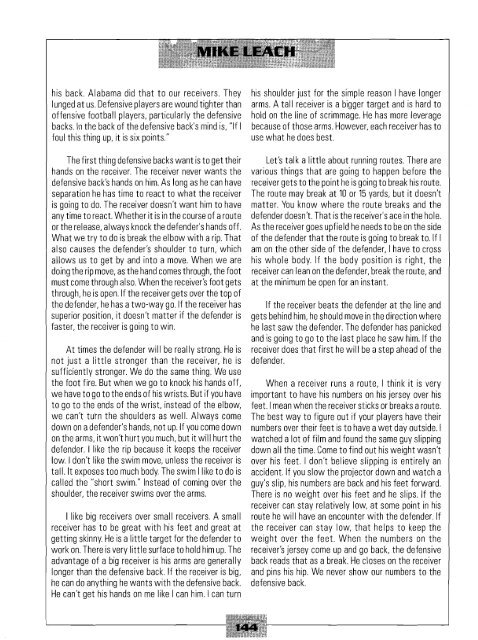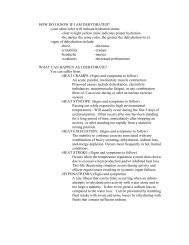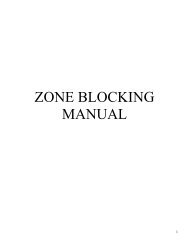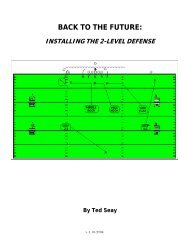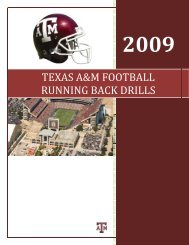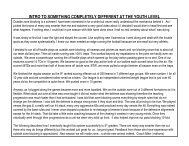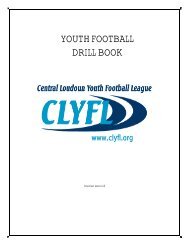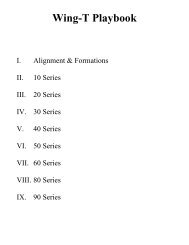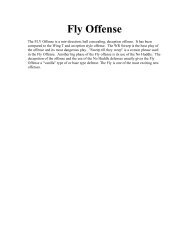Receiver Techniques and Drills - Mike Leach - Gregory Double Wing
Receiver Techniques and Drills - Mike Leach - Gregory Double Wing
Receiver Techniques and Drills - Mike Leach - Gregory Double Wing
Create successful ePaper yourself
Turn your PDF publications into a flip-book with our unique Google optimized e-Paper software.
his back. Alabama did that to our receivers. Theylunged at us. Defensive players are wound tighter thanoffensive football players, particularly the defensivebacks. In tlie back of tlie defensive back's mind is, "If Ifoul this thing up, it is six points."The first thing defensive backs want is to get theirh<strong>and</strong>s on the receiver. The receiver never wants thedefensive back's h<strong>and</strong>s on him. As long as he can haveseparation he has time to react to what the receiveris goiqg to do. 'The receiver doesn't want him to haveany time to react. Whether it is in the course of a routeor the release, always knock thedefender's h<strong>and</strong>s off.What we try to do is break the elbow with a rip. 'Thatalso causes the defender's shoulder to turn, whichallows us to get by <strong>and</strong> into a move. When we aredoing the rip move, as the h<strong>and</strong> comes tl-rough, tlie footmust come through also. When the receiver's foot getsthrough, he is open. If the receiver gets over the top ofthe defender, he has a two-way go. If the receiver hassuperior position, it doesn't matter if the defender isfaster, the receiver is going to win.At times the defender will be really strong. He isnot just a little stronger than the receiver, he issufficiently stronger. We do the same thing. We usethe foot fire. But when we go to knock his h<strong>and</strong>s off,we have to go to the elids of his wrists. But if you haveto go to the ends of the wrist, instead of the elbow,we can't turn the shoulders as well. Always comedown on a defender's h<strong>and</strong>s, not up. If you come downon the arms, it won't hurt you much, but it will hurt thedefender. I like the rip because it keeps the receiverlow. I don't like the swim move, unless the receiver istall. It exposes too much body. The swim I like to do iscalled the "short swim." Instead of coming over theshoulder, the receiver swims over the arms.I like big receivers over small receivers. A smallreceiver has to be great with liis feet <strong>and</strong> great atgetting skinny. He is a little target for the defender towork on. There is very little surface to hold him up. Theadvantage of a big receiver is his arms are generallylonger than the defensive back. If the receiver is big,lie can do anything he wants with the defensive back.He can't get his h<strong>and</strong>s on me like I can him. I call turnhis shoulder just for the simple reason I have longerarms. A tall receiver is a bigger target <strong>and</strong> is hard tohold on the line of scrimmage. He has more leveragebecause of those arms. However, each receiver has touse what lie does best.Let's talk a little about running routes. There arevarious things that are going to happen before thereceiver gets to the point he isgoing to break his route.The route may break at 10 or 15 yards, but it doesn'tmatter. You know where the route breaks <strong>and</strong> thedefender doesn't. That is the receiver's ace in tlie hole.As the receiver goes upfield he needs to be on the sideof the defender that the route is going to break to. If Iam on the other side of the defender, I have to crosshis whole body. If the body position is right, thereceiver can lean on tlie defender, break .the route, <strong>and</strong>at the minimum be open for an instant.If the receiver beats the defender at the line <strong>and</strong>gets behind him, he should move in the direction wherehe last saw -the defender. The defender has panicked<strong>and</strong> is going to go to tlie last place he saw him. If thereceiver does that first he will be a step ahead of thedefender.When a receiver runs a route, I think it is veryimportant to have his numbers on his jersey over hisfeet. I mean when the receiver sl:icks or breaks a route.The best way to figure out if your players liave theirnumbers over their feet is to have a wet day outside. Iwatched a lot of film <strong>and</strong> found the same guy slippingdown all the time. Come to find out his weight wasn'tover his feet. I don't believe slipping is entirely anaccident. If you slow the projector down <strong>and</strong> watch aguy's slip, his numbers are back <strong>and</strong> his feet forward.There is no weight over his feet <strong>and</strong> he slips. If thereceiver can stay relatively low, at some point in hisroute he will have an encounter with the defender. Ifthe receiver can stay low, that helps to keep theweight over the feet. When tlie numbers on thereceiver's jersey come up <strong>and</strong> go back, the defensiveback reads that as a break. He closes on the receiver<strong>and</strong> pins his hip. We never show our numbers to thedefensive back.


